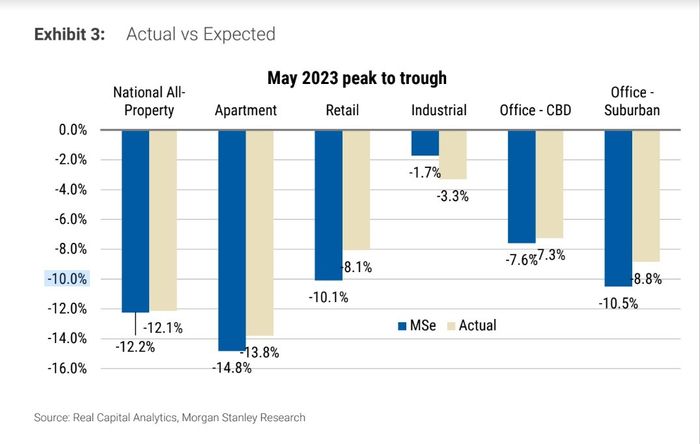In One Chart: Commercial real estate prices are still expected to crater, Morgan Stanley warns
The U.S. economy isn’t the only thing unwilling to capitulate despite sharply higher interest rates.
Commercial real-estate prices have been heading lower in the wake of the pandemic and the Federal Reserve’s inflation fight, but the bulk of the pain still looks poised to come, according to Morgan Stanley analysts.
Prices for apartment buildings, offices properties and retail centers were pegged at about 8%-14% lower in May from peak levels (see chart), or less than Morgan Stanley’s initial estimates (blue line).

Commercial real-estate prices are about 12% lower nationally, but still expected to fall by almost 30% in this cycle.
Real Capital Analytics, Morgan Stanley Research
But the worst for property owners looks yet to come, according to Morgan Stanley’s REIT research team led by Ronald Kamden. The team reiterated its call for a 27.4% peak-to-trough price drop for all commercial property types through the end of 2024.
That compares with a 34.9% drop roughly 15 years ago during the global financial crisis, but also a subsequent period in which prices rose nearly 150% through the pandemic, according to Morgan Stanley data.
Prices have been heading lower overall, but with retail, industrial and office properties in the suburbs and central business districts, still facing the majority of their anticipated price declines “as transaction activity and distressed sales rise,” the team wrote in a Monday client note.
Up to 42% price drop?
Half-empty office buildings in the heart of financial districts in major U.S. cities are expected to be hit particularly hard by hybrid work, tighter credit and higher interest rates.
See: San Francisco’s office market erases all gains since 2017 as prices sag nationally: chart
New York magazine recently wrote how big Manhattan office landlords are looking to shed buildings now worth less.
The hardest-hit cities could see demand for office buildings tumbling by as much as 38% from 2019 levels, according to a McKinsey Global Institute report from earlier in June. The report also pegged office prices as falling about 26% on average in a moderate scenario through 2023, but skidding 42% in a severe scenario.
BofA Global researchers led by Alan Todd also said that pressure in the office sector could “spill over” into other property types, including hotels and retail, by making refinancing more difficult.
“For example, to the extent airline costs remain elevated, flight cancellations remain a common problem, or corporate belt tightening limits fly-to in person meetings, we see it as a headwind for hotel revenues, which can fluctuate significantly with the public’s ability or willingness to travel,” Todd’s team wrote, in a weekly client note.
The Dow Jones Equity REIT index DJDBK, -0.66% was up 3.1% on the year through Monday, according to FactSet. Stocks have punched higher in 2023 in the wake of a resilient U.S. economy, despite the Fed already having raised rates by about 500 basis points to a range of 5%-5.25%.
Fed officials indicated that two more rate hikes could still be in store this year, likely with another 25 basis point rate increase expected later this month. The S&P 500 index SPX, +0.49% was up about 17.8% on the year through Monday, while the Dow Jones Industrial Average DJIA, +0.35% was 4.3% higher and the Nasdaq Composite Index COMP, +0.99% was up 36%, according to FactSet.
Related (February): Losing the trophy? A $45 billion mortgage bill is coming due for some of America’s signature commercial properties
Read next: Do Not Disturb: Tenants brace for more office landlords to go belly up on their property debts

Comments are closed.